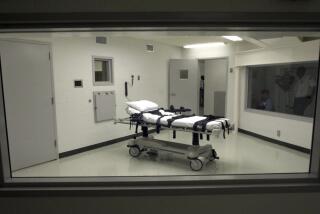California revises execution guidelines
- Share via
California moved a step closer to resuming executions Thursday when corrections officials announced new lethal injection procedures, beating a May 1 deadline by one day.
The proposed changes in the death chamber procedures, though mostly minor, are intended to address concerns expressed by a federal judge in 2006 that the state’s earlier three-drug sequence may have exposed some of those who were executed to unconstitutionally “cruel and unusual punishment.”
Although the new procedures could get final approval by mid-June, executions are unlikely to resume soon because federal and state judges must first review the changes and decide whether they address the constitutional questions and procedural complaints brought by death penalty opponents. Those reviews are likely to extend at least through the end of the year, and other pending legal challenges could keep the current moratorium in effect for months or years.
The details of the execution procedures cover 42 pages and mostly deal with specific procedural questions, including who can serve on the execution team, where witnesses can be located and how to deal with potential mishaps during the process.
California has 702 inmates on death row. Despite having the nation’s largest population of condemned prisoners, there has not been an execution in the state since convicted killer Clarence Allen was put to death in January 2006.
At least six death row inmates have exhausted all appeals and could be scheduled for execution as soon as the legal reviews are completed, said Kent Scheidegger of the Criminal Justice Legal Foundation that supports the resumption of executions.
Terry Thornton, spokeswoman for the California Department of Corrections and Rehabilitation, said Thursday’s submission of the protocols was the final step for the agency in the “rule-making process.” She declined to predict when executions might resume, noting the involvement of other state agencies and the courts.
Opponents of capital punishment accused the state of “tinkering with a broken system.” The Office of Administrative Law now reviewing the new protocols should reject them because they do not respect the religious rights of the inmates or the 1st Amendment rights of the press or the public, and continue to use the paralytic drug that has been blamed in botched executions, said Natasha Minsker, death penalty policy director for the American Civil Liberties Union of Northern California.
A task force named by Gov. Arnold Schwarzenegger initially rewrote the procedures behind closed doors after U.S. District Judge Jeremy Fogel of San Jose ruled that the state procedures were constitutionally flawed. He had heard testimony that some of those executed may not have been fully anesthetized by the first injection before receiving the second shot, the paralyzing agent, and the painful last dose that stops the heart.
Marin County Superior Court Judge Lynn O’Malley Taylor ruled that the task force recommendations were illegal for their failure to be presented to the public for comment and to the administrative law office for review. The corrections department opened the public review process May 1, 2009, and had a year to hold hearings and comb through about 20,000 e-mails and letters on the proposed revisions.
More to Read
Sign up for Essential California
The most important California stories and recommendations in your inbox every morning.
You may occasionally receive promotional content from the Los Angeles Times.











